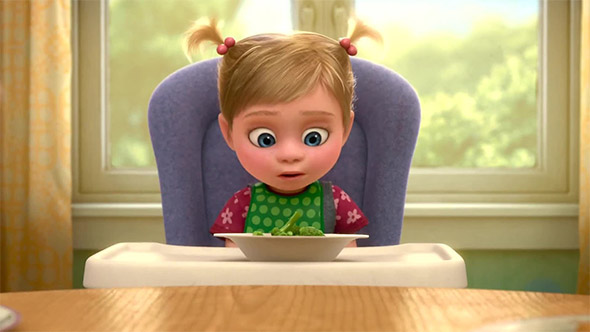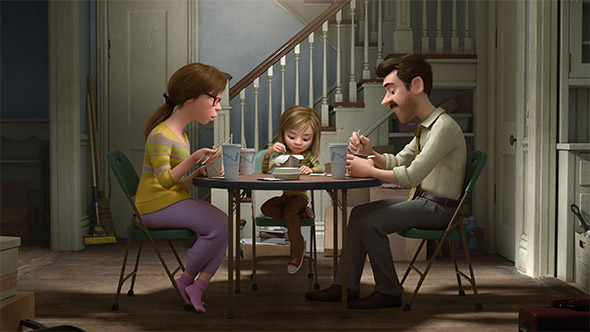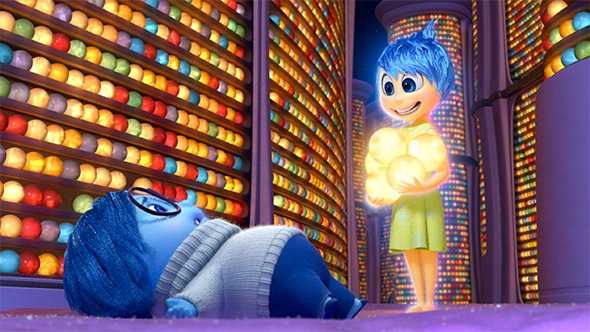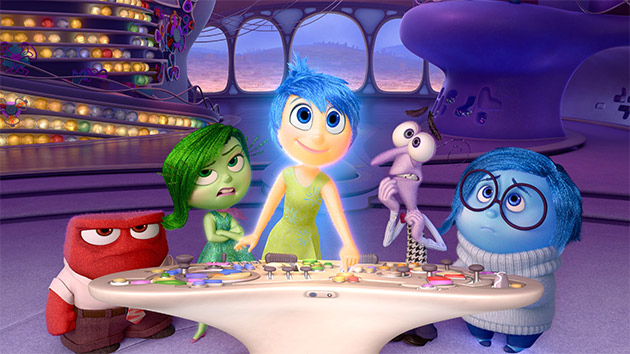Romantic Drama Blue Valentine Served As a Proof of Concept
Disney Pixar’s Inside Out takes place in the outside world where 11-year-old Riley and her parents live, and in the inside world, which takes place largely in Riley’s mind. Pixar tells the interconnected stories simultaneously. We see how emotions affect Riley, and how Riley’s actions affect her emotions. We can also see, if we watch for it closely, how the camera work helped keep those worlds separate until they collide.
“We think of our job a little like editing,” says Patrick Lin, director of photography for camera. “If we do the job well, you don’t notice. We always hope we’re doing something subtle to support the story.”
Stories, in this case: the outside story and the inside story.
Lin led a team of 10 layout artists at Pixar who worked on the film. The job of layout artists is to move storyboards into a three dimensional world. They develop the visual language for the film through character blocking, choreography, and framing. They stage the film; build the shots.
“We give characters their first pose,” Lin says. “We put them in their starting positions. And, we animate objects that move—we do the initial pass for every prop.”
Once the artists have blocked every story beat, they move into shot building to create the timing and the camera moves. In other words, they develop the visual language for the film. Lin describes the visual language for Inside Out.

Developing a Visual Language
“The idea is pretty simple,” he says. “We based the outside world on real locations, so we wanted the camera to feel real and be realistic. Inside was imaginary, so the camera could be more perfect. The plan was to have these two separate styles, which people shouldn’t notice until Act Three.”
Helping convince the layout artists this could be successful was the film Blue Valentine, which alternates between present and past.
“In that film, the camera is more handheld when the characters are young, and they shot it with film,” Lin says. “They shot the present-day scenes with HD. We referenced that film to make sure that cutting between two styles could work.”
Referencing live-action films for the animated feature comes naturally to Lin. He received his degree in live-action filmmaking from the California College of Arts in Oakland, California.
“I never thought I’d work in animation,” Lin says. “I love animation, but I can’t draw.” His first job in the industry was as a camera and lighting assistant for the stop-motion film James and the Giant Peach. That led to work as a motion control photographer on The Truman Show, Soldier, and X-Men. And soon to a fast-track career at Pixar.
Lin was a layout artist on A Bug’s Life, layout sequence lead on Toy Story 2, lead layout artist on Monsters, Inc., and director of photography on The Incredibles, Up, and the short film, “The Blue Umbrella.”
He likes to bring a live-action filmmaking approach to computer animation. Two live-action approaches, in fact, for Inside Out.
Inside, the layout artists used virtual lenses mathematically true to the ARRI/Zeiss Ultra Prime lenses. For the outside world, they chose Cooke S4 lenses.
“We created lens distortion curves in our virtual lenses for each,” Lin says. “The Ultra Prime lenses have minimal lens distortion so we used those in the perfect imaginary inside world. The Cooke S4 lenses have an exaggerated distortion, so those imperfections go into the outside world.”
For shots inside Riley’s mind, Lin and his team referenced cameras used on stage. “We start with a big studio-style camera like those from the 30’s, then reduce the size of the camera as the story progresses,” Lin says. “We moved the camera on straight tracks and used cranes.”
Outside, the layout crew used cameras and designed camera moves as if they were on location; the steadicams, handheld cameras, and unlocked cameras moved more freely. When filming Riley’s Mom and Dad, the camera is tight—foreheads are cropped, chins touch the bottom.
“The biggest difference in the two visual languages, though, is the movement,” Lin says.
“For the inside world, I looked at older films,” he says. “Casablanca, The King and I, and film noir for the graceful camera movements. Then once we get into more agile mechanical camera movement inside, I looked at classic Spielberg films like Indiana Jones and Jurassic Park.”
For the outside world, Lin found films with interesting steadicam shots.
“I like the last shot in Hugo,” he says. “That really, really long one which is a push through the mechanical man and through the window to revisit every character and see how they changed. And, of course we looked at shots with handheld cameras, too.”
In Action
The film starts with Riley’s birth. We meet baby Riley’s emotional character Joy first, then the characters representing Sadness, Anger, Fear, and Disgust.
“In Act One, when we move the camera inside, it’s very graceful and deliberate,” Lin says. “Everything is in control. In the outside world, Riley is free, happy, and lyrical so when the camera moves, we use a steadicam. Her world is big and wide. We have a lot of flat lines.”
In Act Two, Riley and her family move from small town Minnesota to foggy urban San Francisco and the lines change from horizontal to vertical. Riley’s furniture doesn’t arrive. She camps out on the floor in a dank upstairs bedroom. She starts a new school and the teacher calls on her. She clamps down emotionally. Inside, the characters representing her emotions try to help Riley, but nothing works. It’s chaos. Riley’s personality islands are falling apart.
“Inside, we’re still using a mechanical movement and a tracking crane,” Lin says, “but it feels like the camera is smaller because the movement is faster. We do that with a quicker ease in and ease out.”

“Outside,” he says, “we put the camera on a tripod and the only movement is pan and tilt. We’re starting to constrain the camera to represent her mood. Her world becomes smaller and smaller and tighter and tighter through Act Two and Three. And, in Act Two and Three we introduce imperfect focus. In live action films, the focus puller often misses the focus, so we added that to the outside world.”
In Act Three, Riley runs away. Inside, Joy and Sadness have become lost in the memory bank, in abstract thought, in the dream world. They miss the train of thought back to control center.
“Inside, the camera is agile and the movement is faster,” Lin says. “When Joy falls out with Sadness, Joy’s world becomes bigger and bigger and she’s lost. The widest shots in the film are when Joy is completely lost in the memory dump. But, when she learns that Riley needs Sadness, we push into a tight shot. Joy has grown up.”
“Outside,” Lin says, “we lift the camera from the tripod and use a handheld camera as Riley’s world gets even smaller and tighter. The tightest shot is when Riley confesses to her parents and they embrace.”

Camera Capture
When the camera is in Riley’s outside world, the layout artists created camera moves by capturing and applying data from real world cameras tracked in a motion capture room. The first time Pixar had used camera capture was for the short film “Blue Umbrella.” Lin was the DP on that film.
“The story in ‘Blue Umbrella’ is realistic so I wanted a realistic camera movement,” he says. “It was an experiment, but I liked the process and I liked the look. Because we wanted two distinct visual styles for Inside Out, it seemed like the natural choice for the outside world.”
For this film, the studio upgraded the system used for “Blue Umbrella” from a sound-based tracking system to an infrared system, improving the workflow and accuracy. For handheld shots, they created a shoulder rig.
“Basically, they film holding an iPad,” Lin says. “But, the iPad’s movement, its pivot point, is different from a real camera, so we put the tracker on the shoulder rig in the right place.”
For steadicam shots, they used a tripod.
"We don’t have a steadicam and we didn’t want to bring in an operator,” Lin says. “But, if you hold a tripod by the neck about where the pivot is and you walk around you create steadicam motion without using a steadicam. Of course, we had to massage the data, but it got us more than halfway. We used the camera capture only for the outside world, and always for the outside world when the camera moves. I think people will feel it, but it won’t be obvious.”
New Moves
With Inside Out, Lin pushed Pixar into two new directions, both driven by live-action: It’s the first time the studio modeled virtual lenses on real world lenses. And it’s the first time the layout artists used a motion-captured camera to film scenes in a feature animation.
“The satisfying part of having been on this film is seeing the two worlds working well together, each supporting the story and character development,” Lin says. “We shot two movies in one and combined two into one. That’s what made it fun.”
Did you enjoy this article? Sign up to receive the StudioDaily Fix eletter containing the latest stories, including news, videos, interviews, reviews and more.










